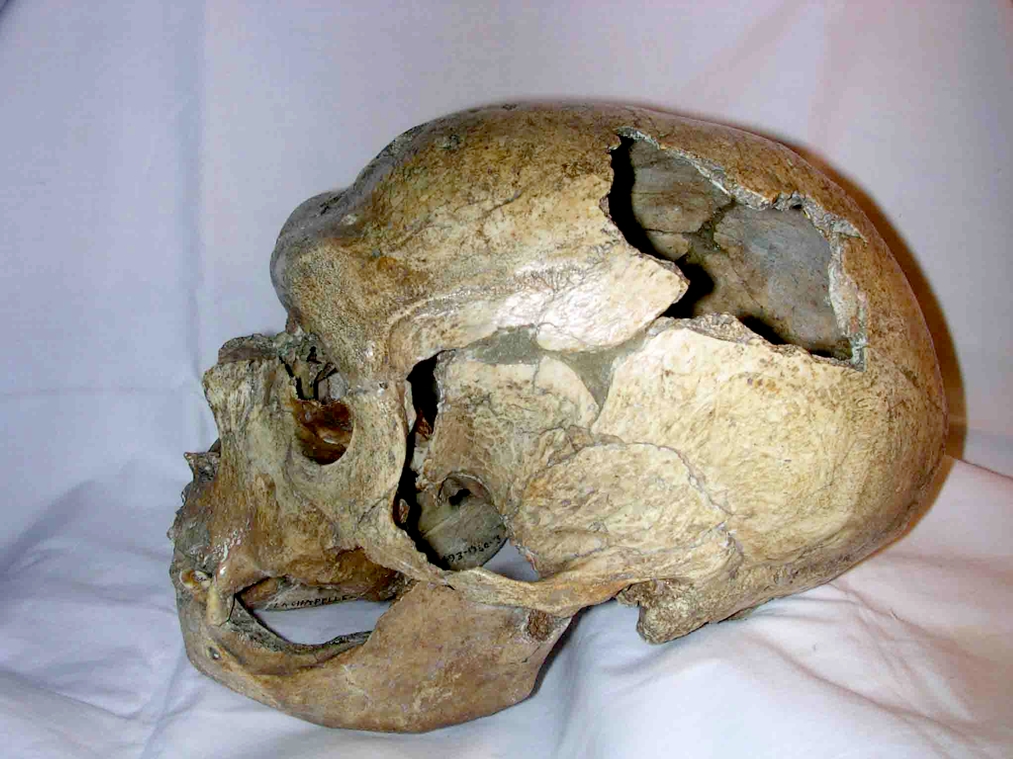|
La Chapelle-aux-Saints 1
La Chapelle-aux-Saints 1 ("The Old Man") is an almost-complete male Neanderthal skeleton discovered in La Chapelle-aux-Saints, France by A. and J. Bouyssonie, and L. Bardon in 1908. The individual was about 40 years of age at the time of his death. He was in bad health, having lost most of his teeth and suffering from bone resorption in the mandible and advanced arthritis. It is the most convincing example of a possible Neanderthal deliberate burial, but like all claimed Neanderthal burials, this isn't generally accepted. The remains were first studied by Marcellin Boule, whose reconstruction of Neanderthal anatomy based on la Chapelle-aux-Saints material shaped popular perceptions of the Neanderthals for over thirty years. The La Chapelle-aux-Saints specimen is typical of "classic" Western European Neanderthal anatomy. It is estimated to be about 60,000 years old. Boule's reconstruction of La Chapelle-aux-Saints 1, published during 1911–1913, depicted Neanderthals with ... [...More Info...] [...Related Items...] OR: [Wikipedia] [Google] [Baidu] |
Homo Neanderthalensis
Neanderthals (, also ''Homo neanderthalensis'' and erroneously ''Homo sapiens neanderthalensis''), also written as Neandertals, are an Extinction, extinct species or subspecies of archaic humans who lived in Eurasia until about 40,000 years ago. While the "causes of Neanderthal disappearance about 40,000 years ago remain highly contested," demographic factors such as small population size, inbreeding and genetic drift, are considered probable factors. Other scholars have proposed competitive replacement, assimilation into the modern human genome (bred into extinction), great climate change, climatic change, disease, or a combination of these factors. It is unclear when the line of Neanderthals split from that of Early modern human, modern humans; studies have produced various intervals ranging from 315,000 to more than 800,000 years ago. The date of divergence of Neanderthals from their ancestor ''Homo heidelbergensis, H. heidelbergensis'' is also unclear. The oldest potential ... [...More Info...] [...Related Items...] OR: [Wikipedia] [Google] [Baidu] |
La Chapelle-aux-Saints
La Chapelle-aux-Saints (; oc, La Chapela daus Sents) is a commune in the Corrèze department in central France. History Neanderthal skeleton The La Chapelle-aux-Saints cave, bordering the Sourdoire valley, revealed many archeological artifacts belonging to the late Mousterian techno-complex,BINANT P., 1991 - ''Les sépultures du Paléolithique''. Paris : Errance including the first ever recognized Neanderthal burial discovered on August 3, 1908. Jean and Amédée Bouyssonie, as well as L. Bardon, led archaeological digs in the cave from 1905 to 1908, discovering over 1,000 pieces of stone industry (mainly flint), bones of different fauna including reindeer, bovid, horse, fox, wolf and even a rhinoceros’ tooth. The most spectacular discovery was that of a very well preserved skeleton of an adult Neanderthal man who appears to have been intentionally buried in a rectangular pit deep, long and wide.NOUGIER L.-R., 1963, ''La préhistoire : essai de paléosociologie religieuse'' ... [...More Info...] [...Related Items...] OR: [Wikipedia] [Google] [Baidu] |
France
France (), officially the French Republic ( ), is a country primarily located in Western Europe. It also comprises of Overseas France, overseas regions and territories in the Americas and the Atlantic Ocean, Atlantic, Pacific Ocean, Pacific and Indian Oceans. Its Metropolitan France, metropolitan area extends from the Rhine to the Atlantic Ocean and from the Mediterranean Sea to the English Channel and the North Sea; overseas territories include French Guiana in South America, Saint Pierre and Miquelon in the North Atlantic, the French West Indies, and many islands in Oceania and the Indian Ocean. Due to its several coastal territories, France has the largest exclusive economic zone in the world. France borders Belgium, Luxembourg, Germany, Switzerland, Monaco, Italy, Andorra, and Spain in continental Europe, as well as the Kingdom of the Netherlands, Netherlands, Suriname, and Brazil in the Americas via its overseas territories in French Guiana and Saint Martin (island), ... [...More Info...] [...Related Items...] OR: [Wikipedia] [Google] [Baidu] |
